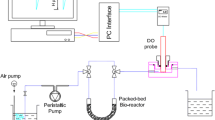Abstract
Introduction
Two semi-specific microbial biosensors were constructed for the analysis of biochemical oxygen demand (BOD) in high-cellulose-content pulp and paper industry wastewaters. The biosensors were based on living cells of Bacillus subtilis and Paenibacillus sp. immobilized in an agarose gel matrix. Semi-specific microorganisms were isolated from various samples (decaying sawdust and rabbit manure) and were chosen based on their ability to assimilate cellulose.
Materials & methods
The biosensors were calibrated with the Organization for Economic Cooperation and Development synthetic wastewater, and measurements with different wastewaters were conducted.
Results
The response time of biosensors using the steady-state method was 20–25 min, and the service life of immobilized microorganisms was 96 days. Detection limit was 5 mg/l of BOD7 while linear ranges extended up to 55 and 50 mg/l of the BOD7 for B. subtilis- and Paenibacillus sp.-based biosensors, respectively. Repeatability and reproducibility of both biosensors were within the limits set by APHA—less than 15.4%. In comparison, both biosensors overestimated the BOD7 values in paper mill wastewaters and underestimated the BOD7 in aspen pulp mill wastewater.
Conclusions
The semi-specific biosensors are suitable for the estimation of organic pollution derived from cellulose, while the detection of pollution derived from tannins and lignins was minor. Better results in terms of accuracy and repeatability were gained with Paenibacillus sp. biosensor.




Similar content being viewed by others
References
APHA (1985) Standard methods for examination of water and wastewater. American Public Health Association, Washington, pp 525–531
Apun K, Jong BC, Salleh MA (2000) Screening and isolation of a cellulolytic and amylolytic Bacillus from sago pith waste. J Gen Appl Microbiol 46:263–267
Chee G-J, Nomura Y, Ikebukuro K, Karube I (2001) Biosensor for the evaluation of biochemical oxygen demand using photocatalytic pretreatment. Sens Actuators B 80:15–20
Chee G-J, Nomura Y, Ikebukuro K, Karube I (2007) Stopped-flow system with ozonizer for the estimation of low biochemical oxygen demand in environmental samples. Biosens Bioelectron 22:3092–3098
Dhall P, Kumar A, Joshi A, Saxsena TK, Manoharan A, Makhijani SD, Kumar R (2008) Quick and reliable estimation of BOD load of beverage industrial wastewater by developing BOD biosensor. Sens Actuators B 133:478–483
Karube I, Matsunaga T, Mitsuda S, Suzuki S (1977) Microbial electrode BOD sensors. Biotechnol Bioeng 19:1535–1547
Kumar A, Dhall P, Kumar R (2010) Redefining BOD:COD ratio of pulp mill industrial wastewaters in BOD analysis by formulating a specific microbial seed. Int Biodeterior Biodegrad 64:197–202
Kwok N-Y, Dong S, Lo W, Wong K-Y (2005) An optical biosensor for multi-sample determination of biochemical oxygen demand (BOD). Sens Actuators B 110:289–298
Kwong AWK, C-y C, Renneberg R (1998) Monitoring biodegradable substances with high-molecular content with a microbial sensor. Anal Lett 31:2309–2325
Liu J, Mattiasson B (2002) Microbial BOD sensors for wastewater analysis. Water Res 36:3786–3802
Liu J, Olsson G, Mattiasson B (2004) Short-term BOD (BODst) as a parameter for on-line monitoring of biological treatment process: Part I. A novel design of BOD biosensor for easy renewal of bio-receptor. Biosens Bioelectron 20:562–570
Maximova N, Dahl O (2007) A set up of a modern analytical laboratory for wastewaters from pulp and paper industry. Chem Soc Rev 36:1323–1349
Nakamura H, Kobayashi S, Hirata Y, Suzuki K, Mogi Y, Karube I (2007) A spectrophotometric biochemical oxygen demand determination method using 2,6-dichlorophenolindophenol as the redox color indicator and the eukaryote Saccharomyces cerevisiae. Anal Biochem 369:168–174
OECD (1984) Activated sludge, respiration inhibition test. OECD Guidelines for the Testing of Chemicals, 1–10
Oota S, Hatae Y, Amada K, Koya H, Kawakami M (2010) Development of mediated BOD biosensor system of flow injection mode for shochu distillery wastewater. Biosens Bioelectron 26:262–266
Rastogi S, Kumar A, Mehra NK, Makhijani SD, Manoharan A, Gangal V, Kumar R (2003a) Development and characterization of a novel immobilized microbial membrane for rapid determination of biochemical oxygen demand load in industrial waste-waters. Biosens Bioelectron 18:23–29
Rastogi S, Rathee P, Saxena TK, Mehra NK, Kumar R (2003b) BOD analysis of industrial effluents: 5 days to 5 min. Current Appl Phys 3:191–194
Raud M, Linde E, Kibena E, Velling S, Tenno T, Talpsep E, Kikas T (2010) Semi-specific biosensors for measuring BOD in dairy wastewater. J Chem Technol Biotechnol 85:957–961
Raudkivi K, Tutt M, Talpsep E, Kikas T (2008) Pseudomonas putida P67.2 and Pseudomonas flourescens P75 based microbial sensors for biochemical oxygen demand (BOD) measurements in phenolic wastewaters of oil shale industry. Oil Shale 25:376–386
Reiss M, Heibges A, Metzger J, Hartmeier W (1998) Determination of BOD-values of starch-containing waste water by a BOD-biosensor. Biosens Bioelectron 13:1083–1090
Tag K, Kwong AWK, Lehmann M, Chan C, Renneberg R, Riedel K, Kunze G (2000) Fast detection of high molecular weight substances in wastewater based on an enzymatic hydrolysis combined with the Arxula BOD sensor system. Wiley, New York, pp 1080–1082
Tan TC, Wu C (1999) BOD sensors using multi-species living or thermally killed cells of a BODSEED microbial culture. Sens Actuators B 54:252–260
Thévenot DR, Toth K, Durst RA, Wilson GS (2001) Electrochemical biosensors: recommended definitions and classification. Biosens Bioelectron 16:121–131
Thompson G, Swain J, Kay M, Forster CF (2001) The treatment of pulp and paper mill effluent: a review. Bioresour Technol 77:275–286
Wang J, Zhang Y, Wang Y, Xu R, Sun Z, Jie Z (2010) An innovative reactor-type biosensor for BOD rapid measurement. Biosens Bioelectron 25:1705–1709
Acknowledgments
We gratefully acknowledge the support of the Estonian Science Foundation (grant ETF 9136) and the target-financed project of the Estonian Ministry of Education and Research NoSF0180135s08, named “Processes in macro- and microheterogeneous and nanoscale systems and related technological applications.”
Author information
Authors and Affiliations
Corresponding author
Additional information
Responsible editor: Philippe Garrigues
Rights and permissions
About this article
Cite this article
Raud, M., Tutt, M., Jõgi, E. et al. BOD biosensors for pulp and paper industry wastewater analysis. Environ Sci Pollut Res 19, 3039–3045 (2012). https://doi.org/10.1007/s11356-012-0817-0
Received:
Accepted:
Published:
Issue Date:
DOI: https://doi.org/10.1007/s11356-012-0817-0




